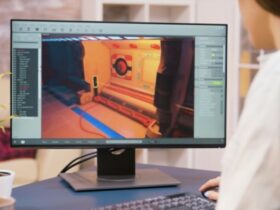Introduction Of How To Build A Budget PC In 2022
How To Build A Budget PC In 2022. If you’re like most people, you probably don’t have a clue what a budget PC is. And if you do, it’s likely that your definition is skewed in favour of the latest and greatest hardware. In this post, we will walk you through the basics of building a budget PC in 2022. By following these simple steps, you can build a PC that’s both powerful and affordable. So if you’re looking to upgrade your computer in the future but don’t want to break the bank, read on for our tips.
Understand your spending habits
When it comes to building a budget PC, understanding your spending habits is key. Start by creating a list of all the expenses you incur on a monthly basis, whether it’s rent, utilities, groceries or anything else. Once you have that list, start categorizing those expenses into categories like entertainment, transportation, bills and others. It’s also important to track your income so you know how much money you are actually spending each month. Once you have all this information, it’s time to build your budget PC.
The first step is to figure out what type of computer you need. Do you want a desktop computer or a laptop? Desktop computers tend to be larger and more expensive than laptops, but they offer more storage and processing power. Laptops are also portable and offer more features than desktops, but they can be less expensive and less powerful. Before making any decisions, it’s important to determine what kind of computing needs you have and which type of computer will meet those needs the best. You Can Also Read The Best Thermo Scientific Tips Every Scientist Should Know.
After deciding on the type of computer you need, it’s time to figure out the cost of that machine. There are many different types of PCs available on the market today, so it can be difficult to estimate the price tag for your specific needs. Luckily, there are several websites available that can help you find the right machine for your budget.
Track your spending
In order to create a budget PC, you first need to track your spending. Start by creating a monthly budget column in Excel or a similar program. List all of your regular expenses, including groceries, utilities, rent, and other bills. Then list all of your income sources and subtract the expenses from the income. This will give you your net worth for the month.
Now create a second column that lists all of the necessary equipment for gaming and productivity. Include everything from your graphics card to your mouse and keyboard. Be sure to include any software that you use regularly, like Office or Photoshop. Once you have added up all of your equipment costs, subtract them from your net worth to get your gaming or productivity budget limit for that month.
Continue this process every month until you have built up a year-long budget. Then start cutting back on your spending whenever there is a surplus in one category over another, or when an expense comes up that you haven’t accounted for before. With careful planning and tracking, it’s easy to build yourself a budget PC without taking too much damage to your bank account
Create a monthly budget
Creating a budget is essential for anyone looking to save money. By understanding your spending patterns, you can create a budget that fits your needs and priorities.
To create a budget, start by identifying your monthly expenses. This includes everything from rent and utilities to groceries and entertainment. Once you have a list of your monthly expenses, divide them into two categories: fixed costs and variable costs.
Fixed costs are those that don’t change month-to-month, such as rent or mortgage payments. Variable costs are those that tend to increase or decrease depending on the month, like grocery bills or entertainment expenses.
Once you have divided your expenses into these two categories, you can begin to figure out how much money you need each month to cover them. To do this, multiply your fixed costs by the number of months in the year (12 in this example) and add it to your variable costs. You’ll end up with your monthly budget amount.
Remember to always adjust your budget as needed – life changes happen frequently, so make sure to keep track of new information as it comes up! And remember: if you’re struggling to stick to a budget, don’t be afraid to ask for help from friends or family members – they might be able to point you in the right direction!
Set realistic goals
Building a budget PC can be daunting, but there are a few key things to keep in mind. First, make sure the components you choose fit your needs and budget. Second, don’t forget to factor in extras like software and accessories. Finally, be patient – building your own PC can take some time, but the end result will be worth it.
To get started, first determine what type of computer you need. Do you want an entry-level computer that can handle basic tasks like browsing the web and emailing? Or do you want something more powerful that can handle more demanding tasks like video editing or gaming? Once you know what type of computer you need, next decide how much money you want to spend. The good news is that there are a variety of affordable computers available on the market today. You can start with a low-end computer and upgrade or add additional components as needed over time.
One important thing to keep in mind when building your budget PC is accessories and software. Not all computers come preloaded with the necessary software required for certain tasks like video editing or gaming. In addition, many expensive software titles are available as free trials before they require purchase. Be sure to check out software recommendations from friends or online resources before making a purchase so that you aren’t stuck with features that you cannot use or don’t want.
The last step in assembling your budget PC is patience! Building a PC from scratch can be
Make small changes to save money
There are a few easy ways to save money on your next computer build. The first is to think about what you really need and limit yourself to that. Second, be selective about the components you choose. Third, take advantage of deals and discounts available on specific components and peripherals. Finally, software is another area where savings can be made. By using free or discounted software, you can cut down on your overall costs considerably.
Consider using a personal finance app
When it comes to budgets, many people turn to personal finance apps. These apps can help users set budgets and track their spending. They can also provide tips on how to save money and make better decisions when spending.
There are a number of great personal finance apps available for both Android and iOS devices. Here are five of the best:
1. Mint: This app is popular for a reason – it’s effective at helping people manage their finances. Mint has a number of features, including an easy-to-use budgeting tool, automatic categorization of expenses, and reminders to save money. It also offers helpful tips on how to save money and live smarter with your money.
2. YNAB: This app is perfect for people who want to get serious about budgeting. YNAB provides users with an easy way to create budgets, track expenses, and generate reports detailing their progress over time. It also has powerful tools for automating your finances so you can focus on what matters most – living life!
3. AceMoney: This app is perfect for users who want more control over their finances than the built-in features offered by some personal finance apps. AceMoney lets you customize your budget, track your debts and savings goals, set up alerts and rules for spending, and more. Plus, it offers great advice on how to improve your financial situation in general!
4. Simple Finance: This app is geared
Evaluate your debt situation
If you’re like most people, your debt situation is probably a little bit complicated. You may have personal, student loan, and credit card debt. It can be tough to figure out where to start when it comes to reducing your debt.
The first step is to create a budget. Figure out how much money you currently spend each month on debts and non-debts items. Then subtract that amount from your monthly income. This will give you an idea of how much extra money you have available each month to reduce your debt.
Next, figure out which debts are causing the most financial stress. Try to pay off high-interest loans first, followed by lower interest loans. Finally, focus on paying off consumer credit cards with the highest interest rates first.
Once you’ve eliminated some of your higher-interest debts, it’s time to start saving for retirement or other long-term goals. You can also consider using debt consolidation services to help reduce your total payments and save on interest rates over time.
Evaluating your debt situation is the first step in reducing your overall indebtedness. Once you know where to start, getting started can be easier than ever!
Invest for the long term
Building a budget PC can be done in a variety of ways. One popular option is to build a custom computer. This guide will outline the steps needed to build one yourself. silicon valley tech editor Matthew Panzarino has compiled a list of the best components to use for a budget PC. These include CPUs, GPUs, motherboards, RAM, storage, and power supplies.
Before starting any construction, it is important to create a budget. This will help determine how much money you can allocate towards each component. Once you have your budget in mind, it is time to start shopping for components. In order to get the best deals, it is important to do your research online and compare prices between different stores.
Make sure to read reviews before making a purchase so that you know what people who have already purchased the product think about it. It is also possible to get discounts by joining loyalty programs or participating in beta testing programs for new products. After purchasing all of your necessary components, it is time to assemble them into a computer.
Stay disciplined
Building a budget PC can be daunting, but by following these simple steps, you can make sure that your machine meets your needs without breaking the bank.
1. Choose a processor.
The first step in building a budget PC is choosing the processor. There are many options available for under $100, and each one offers its own set of benefits and drawbacks. For example, an inexpensive quad-core processor might be sufficient for most basic tasks, but may struggle when it comes to performing more demanding tasks or games. Dual-core processors offer a good compromise between performance and affordability.
2. Choose a motherboard.
Next, select the motherboard that will house your processor and other components. A motherboard is essentially the foundation of your PC, so make sure to choose one that is compatible with the processor you have chosen and has all the features you need (including USB 3.0 ports).
3. Choose RAM and storage drives.
To store your data, select memory (RAM) and storage drives (HDD or SSD). RAM will help speed up your computer while HDD or SSDs will give you faster access to your data – making them ideal for storing large files or accessing frequently used programs and files.
4. Determine what graphics card you need.
If you’re planning on playing games or using sophisticated applications such as photo editors or video editing software, you’ll likely want to invest in a graphics card (or cards). Graphics cards are available in different
Conclusion
In this article, we will be discussing how to build a budget PC in 2022. It is important to remember that no two budgets are the same, so what might work for one person might not work for another. However, by following some simple guidelines and following trends, it should be relatively easy to come up with a figure that works within your budget. In the end, all you need is perseverance and willingness to do some research!


















Leave a Reply
View Comments